Do you have a question about the Triumph Tiger 900 GT 2024 and is the answer not in the manual?
Warnings regarding motorcycle design, towing, sidecars, and passenger capacity.
Dangers of carbon monoxide poisoning from exhaust fumes and petrol flammability.
Importance of helmets, eye protection, and appropriate riding attire.
Specific recommendations for motorcycle clothing and brightly coloured gear.
Hazards of non-approved parts and the importance of genuine accessories.
Importance of correct operation and functioning equipment.
Warnings about licensing, training, and defensive riding.
Importance of operating within speed limits and reducing speed in hazardous conditions.
Importance of maintaining grip on handlebars and using footrests.
Detailed explanation of the motorcycle's instrument panel layout and symbols.
General information on red and amber warning lights and their immediate actions.
Explanation of the MIL light, its function, and potential limp-home mode.
What the low oil pressure warning light indicates and necessary actions.
Meaning of the ABS warning light flashing or remaining illuminated.
How the OCABS warning light behaves in different riding modes.
When the TC indicator light illuminates and what it signifies.
Actions required when the tyre pressure warning light illuminates.
How TPMS warning light and symbols indicate faults.
Further summary of warning lights and messages.
What happens when the engine coolant becomes dangerously high.
Descriptions of ABS settings for Road, Off-Road, and Off modes.
Descriptions of Traction Control settings for Road, Rain, Sport, Off-Road, and Off.
How to enable or disable the Traction Control system.
Risks associated with sticking or damaged throttle controls.
How traction control helps maintain traction and its limitations.
Risks associated with faults in the TC system, especially during cornering.
How TPMS sensors work and how data is displayed.
Importance of correct tyre pressures, checking them cold, and not using TPMS for adjustment.
Safety instructions and warnings associated with refuelling the motorcycle.
Guidance on the running-in process for optimal performance and longevity.
Importance and list of daily safety checks before riding.
Warnings and advice on proper braking techniques, including emergency braking.
Warnings about braking in different conditions, coasting, and foot placement.
Warnings about ABS function, limitations, and when it may require longer stopping distance.
Warnings about riding off-road with ABS disabled and using non-recommended tyres.
What the ABS warning light indicates regarding function availability.
How OCABS provides increased control, its limitations, and when it is disabled.
Warnings about OCABS function, stopping distance, and interaction with lean angle.
Warnings and cautions related to parking the motorcycle safely.
Checks for Electrical Equipment, Engine Oil, Drive Chain, Fuel, Luggage, Steering, and Tyres.
Warnings about incorrect maintenance and the importance of professional servicing.
Continues the detailed table of maintenance tasks.
Importance of maintaining correct engine oil level and changing oil/filter.
How to check the engine oil level correctly using the sight glass.
Dangers of low oil pressure and running the engine with low oil.
Detailed steps for inspecting the engine oil level accurately.
Warnings and procedure for changing engine oil and filter.
Steps for changing engine oil and filter, including torque specs and oil type.
Recommended engine oil specifications and viscosity based on ambient temperature.
Importance of checking coolant level and warnings about coolant handling.
Warnings about handling OAT coolant, its toxicity, and protective measures.
How to check the coolant level in the expansion tank when the engine is cold.
How to adjust the coolant level and warnings about hot coolant.
How to check throttle operation for smoothness and free play.
How to adjust clutch lever free play using lever and cable adjusters.
Dangers of a loose or worn drive chain and maintenance requirements.
How and when to lubricate the drive chain, and cleaning advice.
How to inspect the drive chain for correct vertical movement.
Drive chain vertical movement ranges and adjustment method.
Steps to adjust drive chain free movement and tightening torques.
Warnings about proper torque for wheel spindle and adjuster lock nuts.
Warnings about replacing worn chains and sprockets, and drive chain damage inspection.
How to measure drive chain length for wear.
How to inspect sprockets for unevenly worn or damaged teeth.
Information on brake system, wear inspection, and breaking-in procedures.
How to inspect brake pads for wear.
Warnings about hygroscopic nature of brake fluid and replacement requirements.
Warnings related to ABS function and braking too hard.
Warnings about low fluid levels and how to inspect the front brake fluid reservoir.
How to check the front brake fluid level.
Steps to fill the front brake fluid reservoir and warnings about over-tightening.
How to inspect and adjust the rear brake fluid level.
How to check the rear brake fluid level.
How to adjust the front spring preload on the Tiger 900 Rally Pro.
How to adjust front compression damping for Rally Pro and GT/GT Pro models.
How to adjust front rebound damping for Rally Pro and GT/GT Pro models.
Warnings about front fork maintenance and cautions regarding pressurized oil.
How to adjust the rear spring preload on the Tiger 900 GT/Rally Pro.
How to adjust rear rebound damping for GT and Rally Pro models.
Warnings about using correct tyre types (tubeless) and inner tubes.
Warnings about incorrect tyre pressures and their effects on stability and control.
How tyre wear affects susceptibility to punctures and when to replace tyres.
Table detailing minimum tread depth requirements for safe tyre operation.
Importance of approved tyres, fitting, balancing, and breaking-in new tyres.
Warnings about mixing tyres, tube types, punctures, damage, and incorrect seating/pressure.
How non-recommended tyres affect ABS function and approved tyre lists.
Importance of accurate wheel balance and warnings about balance weights.
Warnings about battery acid contact and safe handling.
Warnings about battery charging and causes of permanent damage.
Recommended steps for charging the battery, including using approved chargers and voltage checks.
Steps for installing the battery, reconnecting leads, and securing components.
Warnings about fuse replacement and identifying blown fuses.
Table detailing fuse positions, circuits protected, and ratings for Fuse Box 1.
Identification of fuses in Fuse Box 2 for GT/Rally Pro and GT Pro models.
How to adjust the headlight beam vertically.
Details on engine arrangement, displacement, bore, stroke, compression, etc.
Details on coolant type, ratio, capacity, and thermostat opening temperature.
Details on fuel injection, injector type, fuel pump, and pressure.
Fuel type and tank capacity.
Details on transmission type, clutch, and gear ratios.
Details on final drive type, ratio, chain, and adjustment.
Recommended cold tyre pressures for the motorcycle.
Warnings about tyre pressures for off-road vs on-road use and stability.
Specifications for tightening various motorcycle components.
Specifications for bearings, brake fluid, coolant, drive chain, and engine oil.
Rally Pro engine details: arrangement, displacement, bore, stroke, etc.
Rally Pro coolant details: type, ratio, capacity, thermostat temperature.
Rally Pro fuel system details: injection, injector, pump, pressure.
Rally Pro fuel type and tank capacity.
Rally Pro transmission type, clutch, and gear ratios.
Rally Pro final drive details: type, ratio, chain, adjustment.
Torque specifications for various components on the Rally Pro model.
Rally Pro fluid and lubricant specifications.
Warnings regarding motorcycle design, towing, sidecars, and passenger capacity.
Dangers of carbon monoxide poisoning from exhaust fumes and petrol flammability.
Importance of helmets, eye protection, and appropriate riding attire.
Specific recommendations for motorcycle clothing and brightly coloured gear.
Hazards of non-approved parts and the importance of genuine accessories.
Importance of correct operation and functioning equipment.
Warnings about licensing, training, and defensive riding.
Importance of operating within speed limits and reducing speed in hazardous conditions.
Importance of maintaining grip on handlebars and using footrests.
Detailed explanation of the motorcycle's instrument panel layout and symbols.
General information on red and amber warning lights and their immediate actions.
Explanation of the MIL light, its function, and potential limp-home mode.
What the low oil pressure warning light indicates and necessary actions.
Meaning of the ABS warning light flashing or remaining illuminated.
How the OCABS warning light behaves in different riding modes.
When the TC indicator light illuminates and what it signifies.
Actions required when the tyre pressure warning light illuminates.
How TPMS warning light and symbols indicate faults.
Further summary of warning lights and messages.
What happens when the engine coolant becomes dangerously high.
Descriptions of ABS settings for Road, Off-Road, and Off modes.
Descriptions of Traction Control settings for Road, Rain, Sport, Off-Road, and Off.
How to enable or disable the Traction Control system.
Risks associated with sticking or damaged throttle controls.
How traction control helps maintain traction and its limitations.
Risks associated with faults in the TC system, especially during cornering.
How TPMS sensors work and how data is displayed.
Importance of correct tyre pressures, checking them cold, and not using TPMS for adjustment.
Safety instructions and warnings associated with refuelling the motorcycle.
Guidance on the running-in process for optimal performance and longevity.
Importance and list of daily safety checks before riding.
Warnings and advice on proper braking techniques, including emergency braking.
Warnings about braking in different conditions, coasting, and foot placement.
Warnings about ABS function, limitations, and when it may require longer stopping distance.
Warnings about riding off-road with ABS disabled and using non-recommended tyres.
What the ABS warning light indicates regarding function availability.
How OCABS provides increased control, its limitations, and when it is disabled.
Warnings about OCABS function, stopping distance, and interaction with lean angle.
Warnings and cautions related to parking the motorcycle safely.
Checks for Electrical Equipment, Engine Oil, Drive Chain, Fuel, Luggage, Steering, and Tyres.
Warnings about incorrect maintenance and the importance of professional servicing.
Continues the detailed table of maintenance tasks.
Importance of maintaining correct engine oil level and changing oil/filter.
How to check the engine oil level correctly using the sight glass.
Dangers of low oil pressure and running the engine with low oil.
Detailed steps for inspecting the engine oil level accurately.
Warnings and procedure for changing engine oil and filter.
Steps for changing engine oil and filter, including torque specs and oil type.
Recommended engine oil specifications and viscosity based on ambient temperature.
Importance of checking coolant level and warnings about coolant handling.
Warnings about handling OAT coolant, its toxicity, and protective measures.
How to check the coolant level in the expansion tank when the engine is cold.
How to adjust the coolant level and warnings about hot coolant.
How to check throttle operation for smoothness and free play.
How to adjust clutch lever free play using lever and cable adjusters.
Dangers of a loose or worn drive chain and maintenance requirements.
How and when to lubricate the drive chain, and cleaning advice.
How to inspect the drive chain for correct vertical movement.
Drive chain vertical movement ranges and adjustment method.
Steps to adjust drive chain free movement and tightening torques.
Warnings about proper torque for wheel spindle and adjuster lock nuts.
Warnings about replacing worn chains and sprockets, and drive chain damage inspection.
How to measure drive chain length for wear.
How to inspect sprockets for unevenly worn or damaged teeth.
Information on brake system, wear inspection, and breaking-in procedures.
How to inspect brake pads for wear.
Warnings about hygroscopic nature of brake fluid and replacement requirements.
Warnings related to ABS function and braking too hard.
Warnings about low fluid levels and how to inspect the front brake fluid reservoir.
How to check the front brake fluid level.
Steps to fill the front brake fluid reservoir and warnings about over-tightening.
How to inspect and adjust the rear brake fluid level.
How to check the rear brake fluid level.
How to adjust the front spring preload on the Tiger 900 Rally Pro.
How to adjust front compression damping for Rally Pro and GT/GT Pro models.
How to adjust front rebound damping for Rally Pro and GT/GT Pro models.
Warnings about front fork maintenance and cautions regarding pressurized oil.
How to adjust the rear spring preload on the Tiger 900 GT/Rally Pro.
How to adjust rear rebound damping for GT and Rally Pro models.
Warnings about using correct tyre types (tubeless) and inner tubes.
Warnings about incorrect tyre pressures and their effects on stability and control.
How tyre wear affects susceptibility to punctures and when to replace tyres.
Table detailing minimum tread depth requirements for safe tyre operation.
Importance of approved tyres, fitting, balancing, and breaking-in new tyres.
Warnings about mixing tyres, tube types, punctures, damage, and incorrect seating/pressure.
How non-recommended tyres affect ABS function and approved tyre lists.
Importance of accurate wheel balance and warnings about balance weights.
Warnings about battery acid contact and safe handling.
Warnings about battery charging and causes of permanent damage.
Recommended steps for charging the battery, including using approved chargers and voltage checks.
Steps for installing the battery, reconnecting leads, and securing components.
Warnings about fuse replacement and identifying blown fuses.
Table detailing fuse positions, circuits protected, and ratings for Fuse Box 1.
Identification of fuses in Fuse Box 2 for GT/Rally Pro and GT Pro models.
How to adjust the headlight beam vertically.
Details on engine arrangement, displacement, bore, stroke, compression, etc.
Details on coolant type, ratio, capacity, and thermostat opening temperature.
Details on fuel injection, injector type, fuel pump, and pressure.
Fuel type and tank capacity.
Details on transmission type, clutch, and gear ratios.
Details on final drive type, ratio, chain, and adjustment.
Recommended cold tyre pressures for the motorcycle.
Warnings about tyre pressures for off-road vs on-road use and stability.
Specifications for tightening various motorcycle components.
Specifications for bearings, brake fluid, coolant, drive chain, and engine oil.
Rally Pro engine details: arrangement, displacement, bore, stroke, etc.
Rally Pro coolant details: type, ratio, capacity, thermostat temperature.
Rally Pro fuel system details: injection, injector, pump, pressure.
Rally Pro fuel type and tank capacity.
Rally Pro transmission type, clutch, and gear ratios.
Rally Pro final drive details: type, ratio, chain, adjustment.
Torque specifications for various components on the Rally Pro model.
Rally Pro fluid and lubricant specifications.
| Displacement | 888 cc |
|---|---|
| Bore x Stroke | 78.0 mm x 61.9 mm |
| Compression Ratio | 11.27:1 |
| Fuel System | Multipoint sequential electronic fuel injection |
| Exhaust | Stainless steel 3 into 1 header system, side mounted stainless steel silencer |
| Front Tyre | 100/90-19 |
| Rear Tyre | 150/70R17 |
| Engine Type | Liquid-cooled, 12-valve, DOHC, in-line 3-cylinder |
| Maximum Power | 93.9 hp (70 kW) @ 8, 750 rpm |
| Maximum Torque | 87 Nm @ 7, 250 rpm |
| Final Drive | Chain |
| Clutch | Wet, multi-plate, slip assist |
| Gearbox | 6 speed |
| Front Wheel | Cast alloy, 19 x 2.5 in |
| Rear Wheel | Cast aluminum alloy, 17 x 4.25 in |
| Front Suspension | Marzocchi 45mm upside down forks |
| Rear Suspension | Marzocchi monoshock, adjustable rebound damping and preload |
| Front Brakes | Twin 320mm floating discs, Brembo Stylema 4-piston radial monobloc calipers, Cornering ABS |
| Rear Brakes | Brembo single piston sliding caliper, 255mm disc. Optimised cornering ABS |
| Fuel Tank Capacity | 20 L |
| Instrument Display | 7" TFT multi-functional instrument pack with digital speedometer, trip computer, digital tachometer, gear position indicator, fuel gauge, service indicator, ambient temperature, clock and Rider Modes |
| Height Without Mirror | 1, 410 mm (55.5 in) |
| Riding Modes | Road, Rain, Sport, Rider-configurable |
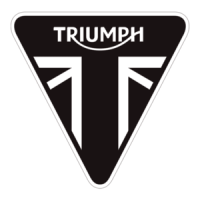

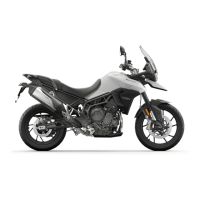
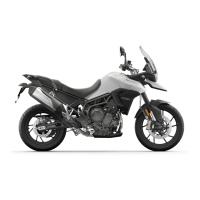

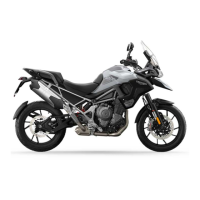
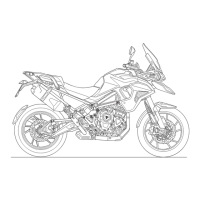
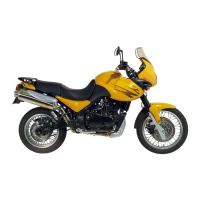
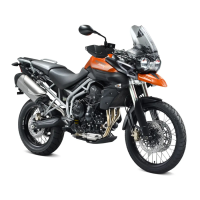
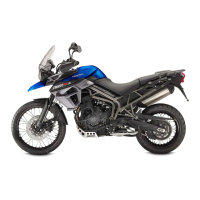
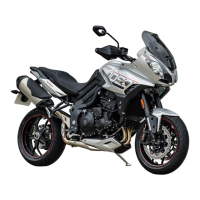
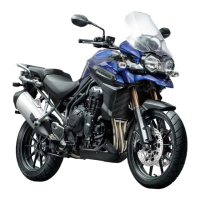
